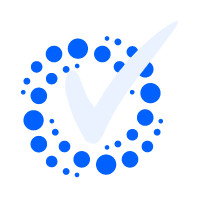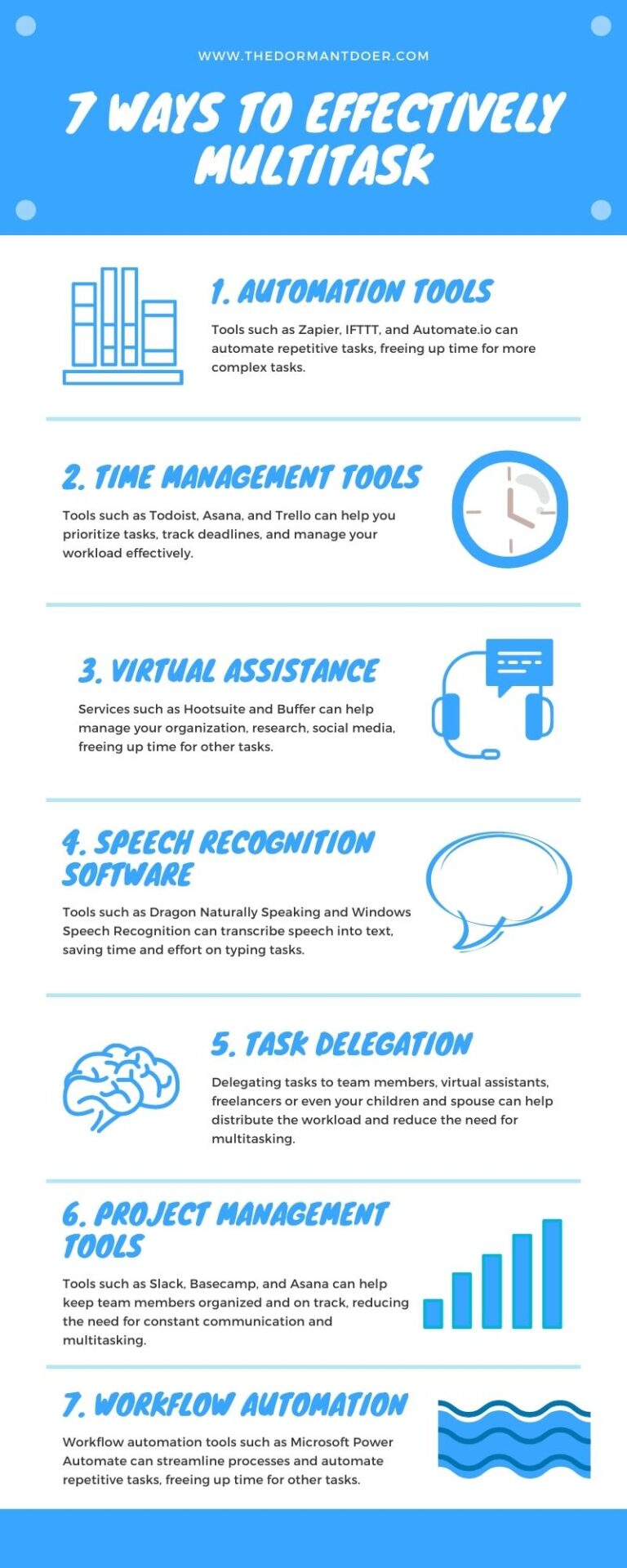THE ULTIMATE GUIDE TO EFFECTIVE MULTITASKING
Everything You Need To Know In One Blogpost
From the medical worker to the manager, from the student to the mother: Everyone does it for different reasons. For some, the feeling of tackling multiple tasks at once can feel rewarding, while others are forced to do it even if they would prefer to take life a bit slower. Welcome to the Dormant Doer! Today we will take a deep dive into the world of multitasking. What is the best way to multitask, how does it affect the brain, and is multitasking even dangerous? These are the questions you will get answered right now!
What is multitasking?
First, let’s become familiar with the socially accepted version of multitasking. At the end of this article, I would like to introduce a more effective version.

A noteworthy part of this definition is the second sentence of the quote. “It is a desirable skill in order to increase productivity and efficiency.” That’s the actual reason why we multitask at all – not because we love to penetrate our brain and mood with a data overload, but because there’s so much going on these days that we want and often need to get multiple things done at the same time. If you asked your grandparents about multitasking, they`d probably glance at you in a skeptical and confused way, because yes, even they did multitask, but not in such a short timespan (“new age rubbish”, quote: Grandmother).
Why Multitasking Feels So Rewarding
If you had to do five tasks within the next two hours and you tackled all of them at the same time, we call it multitasking. If you take one task after the other within these two hours and the result is even better, we don’t call it multitasking anymore, because we did not approach everything at the same moment. And here lies the trigger, why we fall for the “fast thinking” part of our brain, which is according to the renowned decision-making psychologist Daniel Kahneman the unconscious, emotional and instinctive thinking.
The brain rewards us with dopamine, the happiness hormone (apologies to anybody who is well aware what dopamine is) for any small victory during the journey of conducting multiple tasks at the same time. So to say, in order to be more productive and efficient, our brain builds up an illusion where it signals us with little dopamine hits, that we successfully finished one task, even if it was just sticking a spoon of peanut butter into our mouth and scrolling through emails at the same time. You see, our brain is a very poor judge about which accomplishments are great and which are irrelevant. If we don’t recognize that by ourselves it leads us into nirvana with a proud smile 😉
This is the magic recipe, why it is so addictive to multitask: The desire to get more things done plus a dopamine hit for low-quality accomplishments equals the manifestation of ineffective multitasking in our daily behavior. I’d like to note that eating a spoonful of peanut butter is definitely a major and not minor accomplishment!
Is multitasking possible?
You guessed it, there is a big YES and an even bigger NO.
Real multitasking is possible, because we live in an age where technology provides us the tools to conduct multiple tasks at the same time without (I’d like to emphasize this word) without the need to use our personal attention to get the task done. This is the only real way to scale up your ability to multitask almost infinitely.
Is Multitasking A Myth?
Brian Tracy once said that being busy doesn’t mean being productive. All the research about the effectiveness and efficiency of multitasking indicates that multitasking, as we understand it, is not only a myth, but also blatantly dangerous. Our brain is simply not constructed to handle multiple tasks at the same time. It’s like trying to grow apples, bananas, and cherries from the same tree.
Three Reasons Why Traditional Multitasking Is Not Possible:
- Research has shown that even when attempting to do two tasks at the same time, the chance for errors increases significantly (up to 50%) and the process of getting things done is slowed down immensely.
- Multitasking, as most of us do it, only serves one purpose: getting a dopamine hit while completing insignificant tasks quickly. It is difficult to accept, but we live in a time where humans have become painfully good at releasing dopamine on purpose. If our goal is to become more productive and efficient, we must shift our beliefs from “doing multiple tasks at the same time” to “what can I automate, delegate, or terminate” in order to gain more resources for the important things in life. Tim Ferris, the popular biohacking author and entrepreneur, has great ideas on this subject in his book “The 4-Hour Workweek”.
- Our brains cannot focus on two things at the same time. It can only switch between tasks. We are never as focused on both tasks as we believe we are. The time cost for switching between tasks is enormous.
Now you better take a seat, because the following discovery will blow your mind:
Multitasking can cause the grey matter in our brain to disappear, which is the vehicle for neural pathways. It is responsible for being able to memorize and retrieve information, as well as any cognitive process our brain conducts, starting from walking to memorizing names. Grey matter is the grey-ish pink substance of the brain, where all the magic of cognition happens. Multitasking can literally make your brain shrink! A horrifying thought.
Are people who mulitask smart?
Not at all! People who appear to be better multitaskers than others have just more routine, if we use the traditional definition. The more often we multitask the same pattern, the more efficient it gets. However, it is not scalable. By switching between two demanding tasks, our brain is already overloaded. Remember, we are not focusing on both of the tasks, we just switch between them. So no, multitasking in the traditional way is a matter of routine, not intelligence.
What Is The Way To Become A Smart Multitasker? 7 Ways to Effectively Multitask.
It is time to introduce effective multitasking. Read it once, take a quick break to ruminate and unfold its energy and then read it again:
Effective multitasking is the ability to conduct multiple tasks simultaneously without sacrificing quality or requiring one’s own attention.

If we see multitasking as the effective definition mentioned above: “being able to conduct multiple tasks at the same time without the need of your own attention”, then I claim it’s a matter of being smart.
Why Are People Who Effectively Multitask Smart?
Easy example. Most companies you know out there have one name, but behind their name are working various forces to reach and maintain economic success. It’s great that you are an impeccable electrician, but if you don’t manage to hire other people to do electricity, accounting, and marketing for you, you will never be able to scale up your business.
It’s great that you are a super talented musician, but if you cope with various tasks that don’t foster your career, then you’ll never climb up the ladder (yes, playing every weekend in the same bar doesn’t help your career at all. Unfortunately, it doesn’t count as automation).
It’s great, that you are an experienced parent, but if you never manage to delegate responsibilities to your children, you will never be able to have a relaxed time, like other mothers and fathers.
Real, effective multitasking is not about how many balls you can juggle by yourself, but to whom and what you can teach to juggle YOUR own balls. When you went full black belt in teaching you can even automate teaching and make an online juggling course. Sweet thought!
So I ask you: Is it your desire to shred your brain with the sole purpose to get some insignificant dopamine hits, or do you really want to get things done, and maybe awaken a bigger force within you, which you don’t really know about yet?
Multitasking versus mindfulness
Slow down, cowboy! Not everything that demands your attention now has the urgency and the right to do so. Yes, every nurse, father, or mother who reads this sentence may smirk skeptically, but I am one hundred percent convinced that with every profession and task you conduct, you are able to maximize the quality of mindfulness. What’s the difference between mindfulness and multitasking? It’s the exact opposite. With traditional multitasking you give a general permission that it’s okay for you to handle multiple tasks at the same time. With mindfulness on the other side, you consciously commit, that the task you are doing right now
How To Stop The Addiction Of Ineffective Multitasking?
As mentioned above, multitasking is a habit. For some of us it’s hard to see the aim anymore, because of the endless dopamine injections. In the past you decided to be allowed to be pushed back and forth all day long, your whole life. Stopping to multitask and becoming mindful has a few requirements:
- acknowledging that dopamine is released when you finish tasks, even if they are insignificant. The great feeling of multitasking is scientifically proven to be ineffective and a just an illusion of your brain.
- Making the decision to become mindful and stop to multitasking. This is a tricky one, as it requires a true commitment. To help with this, it can be beneficial to have an accountability partner and write commitments on a post-it to pin next to your bed.
- habits are not turned off overnight. it takes time and patience to train yourself. The more often you decide just in the moment to be mindful, stay focused or activate a pre-determined protocol, the stronger your mindfulness muscle becomes and the weaker your overwhelm muscle of ineffective multitasking.
→ Everytime you tell yourself “No, I am going to fully enjoy this meal without reading newspaper or watching tv
→ Everytime you tell yourself, that your colleague is now responsible for work during your lunchbreak and not you
→ Everytime you read a book without any screen nearby
… you are making a commitment to become more mindful and less a dopamine junky.
Which Is Better: Multitasking Or Mindfulness?
It can be a tricky decision whether mindfulness or multitasking is the better option. However, this article should have made it easier for you. Minimize ineffective multitasking as much as possible. Of course, there are times when we really don’t have a choice. However, it is up to you to continually ask yourself: “What can I automate, delegate, or terminate?”
